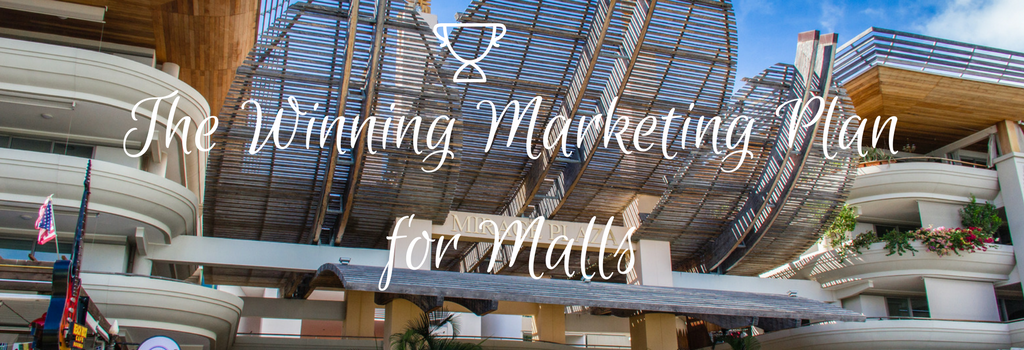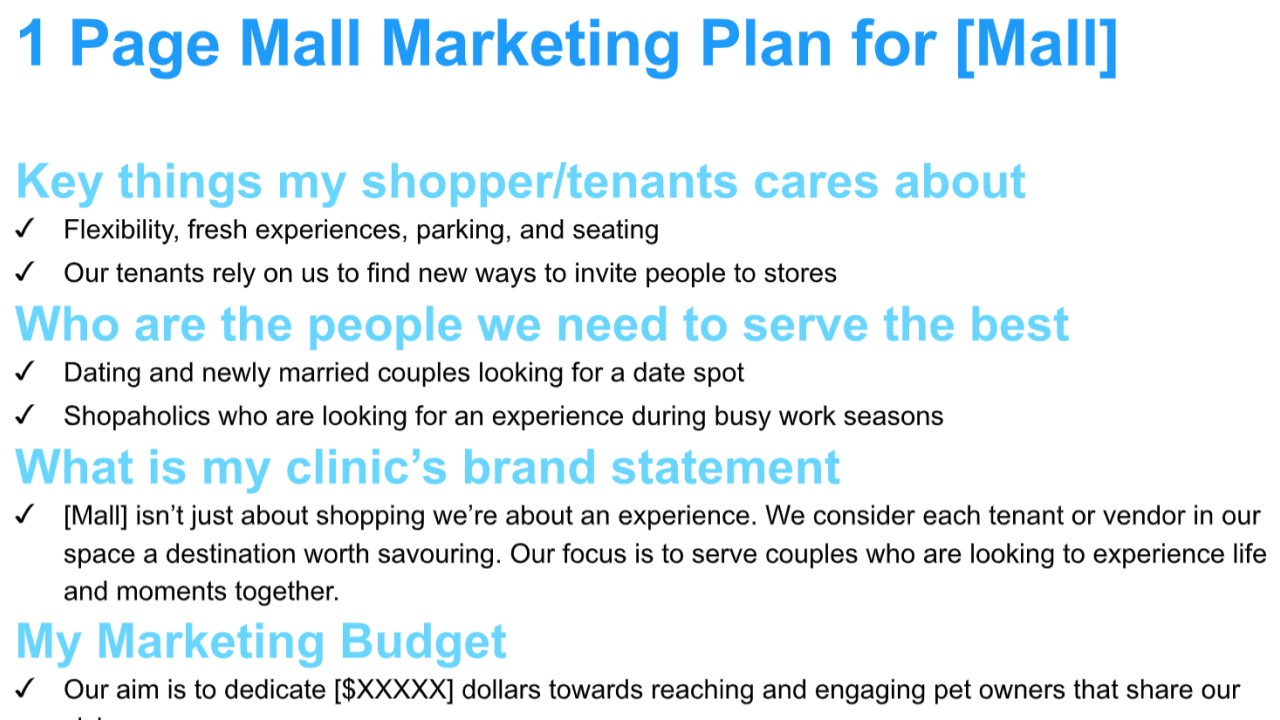Boost Store Traffic with Our Simple 1-Page Mall Marketing Plan
Effective Strategies to Attract More Shoppers and Increase Sales.
In today’s competitive retail environment, mall stores face unique challenges like declining foot traffic, increasing competition from online retailers, and changing shopper behaviors. Without a focused marketing plan, it’s easy to feel overwhelmed trying to attract and retain customers.
That’s why having a clear, actionable strategy tailored to your mall store is essential. A well-designed marketing plan helps you stand out in a crowded marketplace, drive consistent traffic to your store, and create memorable customer experiences that lead to repeat business.
Our 1-Page Mall Marketing Plan provides simple yet effective strategies to overcome these challenges and boost your store’s visibility and sales. Whether you’re looking to attract more shoppers, improve in-store engagement, or gain a competitive edge, this guide is your first step toward success. Click on each section to learn more.
- The Key Consideration for Mall Managers and Owners
- How to Create a Message that Resonates with People Most Likely to Shop
- Describe Your Mall in 1-2 Sentences
- How to Find the Right Audience to Reach and Where to Reach Them
- Set a Marketing Budget
- Determine the Means for Delivering Your Message and Brand
- Set Goals for Your Marketing Plan
- 1 Page Marketing Plan Table of Contents
- Sample One page Marketing Plan
Create loyal fans by understanding your shoppers and tenants with a one page marketing plan. Work with the Profitworks team to help you reach more visitors today!
We empower retailers and malls to find their crowd
We've seen time and again how mall owners want advisors that take the time and care to manage their marketing as if it was their own business. Work with the Profitworks team to help uncover the amazing product and service more people need to hear about.
Executive Summary
- Mall owners and managers continue to face challenges in sustaining foot traffic as eCommerce continues to grow, signalling a need for a more robust yet succinct marketing plan
- The key components of a one page marketing plan include target segment, messaging, and channels
- The one page marketing plan can be summarized as qualities my customer cares about, who is my target customer, what is my brand statement, what is my marketing budget, where will I reach my clients, and what are my marketing goals
- The retail industry is highly competitive and mall management needs to provide great service and creativity if they want to find innovative ways to attract visitors
1. The Key Consideration for Mall Managers and Owners

Our interpretation of a one page marketing plan as popularized by Successwise revolves around two crucial areas.
Malls have been in decline for a number of years, but for those that aren't ready to quit yet, here is where the rebellion against the tide begins, with your one page marketing plan. Use your one page marketing plan as a compass rather than a map. As part of starting a new business and creating a marketing plan, the aim is to create something unique. That is what truly makes an effective marketing plan that is positioned to help your team grow in serving more great people in the company. Using this one page marketing plan will require frequent contact with clients to understand where their needs and their pets' needs are.
Our interpretation of a one page marketing plan as popularized by Successwise revolves around two crucial areas:
- Message - what the predominant themes are that your target customer should know about your mall
- Channel - where these messages should be delivered in a unique or fresh way
2. How to Create a Message that Resonates with People Most Likely to Shop

In order to create a message that resonates with clients, it is important to understand what is valued and how they would articulate these aspirations and needs in their own words. One of the best sources for this is to use Google, Yelp, or Yellowpages reviews to determine what customers find to be important when they are raving about malls or what expectations often go unmet.
Both reinforcing these needs and addressing unmet expectations are great ways to create brand messaging that can help you better connect with your customers. Based on a search on UNIQLO's / Yorkdale Mall's reviews in the Toronto area, here are some things that customers really appreciated:
- Stores being cleaned regularly
- Having people to help on standby
- Patrons also appreciated larger malls having wait lines so that the store isn't cramped
- Customers appreciated the fact that store directories were kept up to date and accessible
- People were fans of the selection of stores
- Decor
Here are some mistakes to avoid:
- Communicate pricing consistently so customers aren't charged more than expected
- Ensure customers understand refund/exchange policy
- Parking and limited seating at the food court contributed to poor experiences
The retail industry is incredibly competitive because of the sheer number of retailers vying for patrons, while online shopping is becoming more widely used than ever before. Without a marketing plan, you are leaving your mall's future viability to chance. From here we identify the target customer base that you would like to aim for.
3. Describe Your Mall in 1-2 Sentences

Why It Matters
Your mall’s description isn’t just an elevator pitch—it’s a tool to differentiate yourself from competitors and communicate your value proposition. Whether it’s your focus on customer service, design, or unique amenities, this short statement should reflect what makes your mall special.
Examples of Effective Descriptions
Highlighting Customer Experience
"Our mall is dedicated to an unparalleled shopping experience, offering comfort and convenience at every turn. From parking to purchase, we prioritize your pace and preferences."
Showcasing Amenities
"Pleasantown Mall ensures you never miss a spot, seat, or moment. With ample parking, cozy food court seating, and exciting new stores, life happens here."
Emphasizing Community Appeal
"At Citywalk Center, we bring together the best in local and global brands with a vibrant atmosphere that celebrates community, creativity, and connection."
How to Craft Your Unique Description
- Conduct Research: Talk to shoppers and retailers to understand what they value most about your mall. Is it the wide selection of stores? The convenience of parking? The welcoming atmosphere?
- Focus on Strengths: Use insights from customer feedback to emphasize what your mall does best, such as excellent customer service, unique decor, or experiential shopping opportunities.
- Keep It Simple: Avoid jargon or overly complex sentences. Use accessible language to ensure your description resonates with a wide audience.
By creating a succinct and memorable description, you not only define your mall’s identity but also help shoppers quickly understand why they should choose your retail destination over others.
4. Find the Right Audience to Reach and Where to Reach Them

Empathize with the shoppers and families you aim to serve.
Identifying and understanding your target audience is key to creating a marketing strategy that resonates with shoppers. While categorizing people may seem limiting, it’s a necessary step to empathize with the shoppers and families you aim to serve. Each audience segment has unique preferences, habits, and motivations, which can inform how you craft your mall’s brand and tailor your marketing efforts.
Shopper Profiles
Here’s a breakdown of common mall shopper types and their characteristics:
Mall Walkers
- Who They Are: Individuals or groups who enjoy walking through the mall, often for exercise or leisure.
- Behavior: Tend to browse stores casually without a strong intent to purchase.
- Marketing Tip: Focus on creating a welcoming and visually appealing environment with plenty of places to rest and snack.
Deal Hunters
- Who they are: Shoppers who thrive on finding the best bargains.
- Behavior: Frequently check for sales and promotions, comparing prices across stores.
- Marketing Tip: Highlight discounts and limited-time offers prominently in your mall’s marketing campaigns.
Retired Seniors

- Who They Are: Seniors who enjoy socializing, staying active, or simply passing time indoors.
- Behavior: Participate in group activities like yoga, tai chi, or mall walking, especially during the morning hours.
- Marketing Tip: Host events or classes targeted at seniors, such as wellness workshops or coffee mornings, to increase foot traffic during off-peak hours.
New Mothers
- Who They Are: Mothers with young children looking for a change of scenery and a place to connect with others.
- Behavior: Often seen in groups, frequenting play areas, family-friendly stores, and food courts.
- Marketing Tip: Emphasize amenities like stroller-friendly spaces, nursing rooms, and kid-friendly stores.
High School Students
- Who They Are: Teenagers who use the mall as a social hub and entertainment space.
- Behavior: Tend to congregate in groups, browsing trendy stores and hanging out in food courts.
- Marketing Tip: Focus on promoting entertainment options, trendy brands, and food court deals to appeal to this audience.
Therapeutic Shoppers
- Who They Are: Individuals who shop as a form of stress relief or self-care.
- Behavior: Enjoy browsing leisurely and often make impulse purchases.
- Marketing Tip: Enhance the shopping experience with calming music, organized displays, and promotions for indulgent items like spa products or premium clothing.
Targeting the Right Audience
- Prioritize Your Top Segment: While it’s tempting to appeal to everyone, focusing on one or two key demographics can help you create a stronger and more loyal following. For example, if your mall has family-friendly amenities, targeting new mothers may be a smart choice.
- Tailor Experiences: Cater your mall’s offerings, events, and promotions to your chosen audience to ensure a more personalized and enjoyable experience.
Building a Brand Around Your Audience
Understanding your audience helps shape your mall’s brand identity. A strong brand is more than just a tagline—it’s a consistent set of themes and values reflected in every aspect of the customer experience. For instance, a mall targeting families could adopt themes of comfort, safety, and convenience, while one focused on therapeutic shoppers might emphasize luxury and relaxation.
By aligning your brand with your target audience’s needs and aspirations, you create a memorable and meaningful shopping experience that keeps them coming back.
5. Set a Marketing Budget

Shopping malls allocate 6-8% of their total annual revenue to marketing and outreach.
Whether you're a new mall operating on a tight budget or a well-established shopping center looking to increase foot traffic, setting a marketing budget is critical. Marketing is not just an expense; it’s an investment in attracting shoppers, retaining tenants, and fostering a thriving retail environment.
How Much Should You Spend?
Industry standards suggest that shopping malls allocate 6-8% of their total annual revenue to marketing and outreach. For example, a mall generating $1,000,000 in revenue annually should ideally invest at least $60,000 (6%) into marketing efforts. This percentage provides a baseline for building campaigns that engage shoppers and boost visibility.
However, it’s understandable that not all malls can dedicate this level of funding to marketing, especially those in the early stages of development. For smaller operations, starting with a lower percentage and focusing on high-impact, low-cost strategies—such as social media outreach or community partnerships—can still yield meaningful results.
Spending Beyond the Minimum
Established malls often exceed the 8% mark, not merely because they can afford to, but because they recognize the tangible return on investment (ROI) that marketing brings. Consistent advertising and promotional efforts translate to increased foot traffic, stronger tenant satisfaction, and enhanced brand reputation. These results justify the higher marketing spend, creating a positive cycle of growth and reinvestment.
The Challenge of Allocation
Setting a budget is only the first step; deciding how to spend it effectively is where the real challenge lies. Malls must balance their marketing dollars across multiple channels—digital advertising, events, promotions, influencer collaborations, and in-mall experiences—to maximize their reach and impact. The next section of this marketing plan delves deeper into strategies for allocating your budget to achieve the best results.
Why Marketing Matters for Malls of All Sizes
Whether large or small, malls can’t afford to overlook marketing. A well-planned budget empowers malls to:
- Drive Foot Traffic: Attract shoppers through strategic advertising and promotions.
- Support Retail Tenants: Help stores thrive by ensuring a steady flow of customers.
- Enhance Reputation: Position the mall as a community hub and go-to shopping destination.
Even with a modest budget, creative and targeted marketing can make a significant difference in achieving your goals. Start by setting an amount that aligns with your revenue and scale your efforts as you grow.
6. Determine the Means for Delivering Your Message and Brand

A strategic mix of classic and creative approaches can ensure that your marketing efforts reach the right audience.
To effectively promote your mall and create a connection with your target visitors, it’s essential to choose the right channels for delivering your message and brand. A strategic mix of classic and creative approaches can ensure that your marketing efforts reach the right audience and stand out in a crowded marketplace.
Classic Marketing Channels
These time-tested methods remain vital tools for promoting your mall and sharing essential information:
Website
A mall's website is the cornerstone of its marketing efforts. It serves as the primary source of information for mall hours, store directories, upcoming events, and news. A well-designed, user-friendly website ensures visitors can easily access what they need.
Media Ads
Traditional media, such as TV commercials and radio spots, are great for building brand awareness and capturing the attention of potential shoppers. These ads are particularly effective for seasonal promotions or grand openings.
Social Media
Social media platforms provide a direct way to interact with visitors, share updates, and run targeted ad campaigns. Engaging content, like contests or behind-the-scenes looks, can boost follower engagement and foster loyalty.
Creative Marketing Channels
Beyond the classic approaches, malls can employ innovative strategies to cut through the noise and create memorable experiences:
-
Host Themed Events
- Date Night Experiences: Collaborate with restaurants, shops, and entertainment venues to create a special evening experience for couples, complete with discounts or exclusive offers.
- Charity Shopping Events: Partner with local charities to host fundraising events where a portion of sales from participating stores supports a good cause.
-
Collaborate with Experts
- Stylist or Designer Tours: Invite personal stylists or interior designers to offer guided tours of your mall, highlighting stores and products that align with specific themes or trends.
-
Family-Friendly Initiatives
- Daycare Partnerships: Offer competitive rental rates to daycares, encouraging families to visit the mall when picking up or dropping off their children.
- Fitness Center Incentives: Attract gym-goers by providing competitive rates to fitness centers and encouraging visitors to shop before or after their workouts.
-
Unique Attractions
- Escape Rooms: Use vacant spaces to host fun, interactive attractions like escape rooms, which can draw in new groups of visitors.
- Pop-Up Shops and Exhibits: Rotate pop-ups to feature local artisans or seasonal products, keeping the mall experience fresh and exciting.
Key Takeaways
By combining classic channels with creative, experiential ideas, your mall can effectively connect with its target audience. Each channel should align with your brand identity and speak to the needs and preferences of your visitors. Experiment with a variety of approaches to determine which resonate best with your community and drive results.
7. Set Goals for Your Marketing Plan

Setting specific and measurable goals helps provide direction and benchmarks for success.
Setting clear, actionable goals is a critical step in creating a successful marketing plan for your mall. While many mall leaders focus primarily on rental income, this singular approach can limit long-term growth. A more effective strategy involves a mindset of learning and curiosity—seeking to understand tenant needs, shopper behaviors, and new trends to continually improve communication and service. Ultimately, this focus on insights can drive growth, enhance tenant satisfaction, and increase foot traffic.
Shift Your Focus Beyond the Bottom Line
Rather than concentrating solely on rental income, consider how insights into tenant and shopper needs can inform better marketing strategies. For example, understanding tenant goals can help create collaborative promotions, while knowing shopper preferences can lead to better-targeted campaigns. This approach fosters a symbiotic relationship between mall management, tenants, and customers.
Example Goals for Mall Leaders
Setting specific and measurable goals helps provide direction and benchmarks for success. Here are some practical examples to get started:
-
Engage with Tenants
- Aim to learn three new things about your mall tenants and how to support their objectives. This could involve hosting feedback sessions, conducting surveys, or having one-on-one conversations with store managers.
-
Explore New Platforms and Communities
- Identify at least two new platforms, communities, or apps that your shoppers use to enhance their daily lives. For example, explore local family-oriented Facebook groups or trending apps that focus on deals and shopping.
-
Encourage Customer Reviews
- Set a goal to receive at least one new Google review—or a review on your platform of choice—each month. Positive reviews boost credibility and provide valuable feedback for improvement.
Monthly Goals vs. Long-Term Goals
Breaking goals into monthly targets makes them more actionable and allows for quicker adjustments based on outcomes. For example, instead of setting a broad annual goal like "increase foot traffic by 10%," focus on smaller, manageable actions like hosting one community event per month. However, if your team has the resources and dedication, quarterly or annual goals can complement these short-term efforts.
Benefits of Goal Setting
By setting clear goals, mall leaders can create a roadmap for growth that balances financial performance with shopper and tenant satisfaction. This structured approach helps track progress, identify what works, and continuously refine marketing efforts to stay ahead of the competition.
8. One-Page Marketing Plan Table of Contents
Now that we've covered the basics of a one page marketing plan, here is an outline to help you get started on your own:
- Key needs and expectations I want to focus on for shoppers and tenants
- Who are the shoppers/tenants that I want to serve
- What is my brand statement (1-2 sentences about my mall experience)
- What are the main ways I will reach these shoppers/tenants
- What are my goals and expected outcomes that I can review
9. Sample One page Marketing Plan
Are you ready to streamline your mall marketing strategy? Download our One-Page Marketing Plan today and gain access to a concise yet powerful tool designed to drive foot traffic, engage shoppers, and support tenant success. This plan provides a clear framework to organize your marketing efforts and focus on actionable goals that deliver results. Whether you're starting from scratch or refining an existing strategy, our sample plan is the perfect starting point.
For a more customized approach, contact us to help tailor the plan to your mall’s unique needs. Our team of experts will work with you to understand your objectives, audience, and tenant mix, ensuring the plan aligns with your goals and maximizes your return on investment. Don't settle for a generic solution—partner with us to create a marketing plan that sets your mall apart. Download the sample or reach out today to get started!
Growing Your Guest Experience
A one page marketing plan is a great way to quickly identify key priorities in reaching the visitors that are looking for convenience and an experience. Marketing, done well, is customer service because it allows a mall to reach and engage in a caring and delightful way. Our hope is that our one page marketing plan for malls can help more retailers serve more families.
Profitworks helps organizations lead with marketing
"I've found Profitworks to be tenacious and adaptable to the challenges our industry possesses."
-Blair - Business Owner & Customer
Read More About What Our Customers Say
We've helped passionate and caring companies across Canada and the US succeed with growth, because we believe in the beauty and meaning of every article written, email sent, and social media post crafted. Our team endeavours to create unique competitive advantages for all of our customers and would be thrilled to learn more about your mission and plans for your team. Profitworks provides marketing strategy, content marketing, branding, and social media management for great companies with a stellar product or service.




